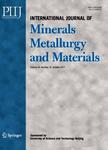Enhanced elevated temperature wear resistance of Al-17Si-5Cu alloy after a novel short duration heat treatment
Enhanced elevated temperature wear resistance of Al-17Si-5Cu alloy after a novel short duration heat treatment作者机构:Department of Metallurgical and Materials Engineering National Institute of Technology Durgapur
出 版 物:《International Journal of Minerals,Metallurgy and Materials》 (矿物冶金与材料学报(英文版))
年 卷 期:2019年第26卷第3期
页 面:360-368页
核心收录:
基 金:financially supported by Department of Science and Technology (India) G.O.I (No. YSS/2014/000172)
主 题:Al-Si alloys isothermal heat treatment wear resistance microstructural investigation
摘 要:The goal of the present study is to improve the elevated temperature wear resistance of an Al-17 wt%Si-5 wt%Cu alloy(AR alloy) by a novel short duration heat treatment process. The elevated temperature(100°C) dry sliding wear behavior of an AR alloy was studied after microstructural modification using the proposed heat treatment. The study revealed considerable microstructural modifications after the heat treatment and the heat treated alloy was designated as HT(heat treatment) alloy. A higher hardness value was obtained for the HT alloy compared to the AR alloy. Accordingly, the wear rate for the HT alloy was found to be significantly lower compared to the as-cast AR alloy at all applied loads. Accelerated particle pull-out for the AR alloy at elevated temperatures resulted in poor wear behavior for it compared to the HT alloy. On the other hand, the Si particles remained intact on the worn surface of the HT alloy due to the good particle/matrix bonding that resulted from the isothermal heat treatment. Furthermore, the age hardening that occurred in the HT alloy during wear provided additional wear resistance. Thus, the HT alloy at 100°C exhibited a lower wear rate compared to the AR alloy even at room temperature for all applied loads. This improvement was attributed to microstructural modification upon isothermal heat treatment along with the age hardening effect.




